Patients are generally receptive to new opioid-free pain management protocol

On June 1, Cleveland Clinic changed its policy for prescribing opioids for C-section patients being discharged from the hospital. Typically, patients were prescribed an average of 21 pills; now, the prescription is for just five pills, and only for patients who used opioids during their hospital stay.
Advertisement
Cleveland Clinic is a non-profit academic medical center. Advertising on our site helps support our mission. We do not endorse non-Cleveland Clinic products or services. Policy
“If they didn’t use a narcotic, they won’t get a prescription for one. But they will get one for Tylenol and Motrin, because it’s safe – and it works,” states Eric Chiang, MD, an anesthesiologist at Cleveland Clinic Fairview Hospital.
Ada Williams, who delivered via C-Section at Fairview Hospital in May, was among the first patients to have a narcotic-free C-section. Recovering from her fourth delivery, all by cesarean section, was much different 37-year-old Williams this time. “I was much more alert. I was able to keep Reighn (newborn daughter) in the room with me the whole time, and it was easier to nurse her,” says Ada. “I went home a day earlier than with my other babies.”
The difference? Ada was administered alternating dose of Tylenol and Motrin, every three hours, after Reighn was born. This new pain relief regimen took the place of conventional pain medication used after C-section: opioids.
“At first, I was skeptical, because the pain can be pretty bad after a C-section,” admits Ada, who was initially informed of the policy change by her obstetrician, Lynnette Karth, MD. “But I didn’t have any problems with pain. This way is much better.”
Dr. Chaing has been the driving force behind the effort to reduce the use of opioids in treating pain for women who are recovering from C-section deliveries. The initial results have been positive – nearly 50% of C-section patients have opioid-free stays, up from just 12% a year ago. The approach is now being adopted by other Cleveland Clinic facilities.
Advertisement
“I got involved, as an anesthesiologist, because I believe we are in a unique position to help solve the opioid crisis,” explains Dr. Chiang. “Because we work in acute care, in the operating room, we probably use more narcotics than any other specialty. We have a responsibility to help determine appropriate pain management given the severity of the opioid crisis.”
According to Dr. Chiang, the time-honored strategy of administering opioids following a C-section delivery was well-intentioned. Poor pain control can make it difficult for new mothers to learn how to care for a newborn, prolong recovery and increase the likelihood of suffering postpartum depression. However, opioid medication comes with severe side effects, including sluggishness, dizziness, nausea, vomiting and breathing issues.
And, of course — the potential for addiction.
The Centers for Disease Control and Prevention reports 68% of drug overdose deaths involve an opioid (including prescription opioids and illegal opioids, like heroin and illicitly manufactured fentanyl). 130 Americans die every day from an opioid overdose.
According to Dr. Karth, who provided pre and post-operative care for Ada, patients have generally been very receptive to the drug protocol change. “It’s important to talk about it long before they get to the operating room,” she adds. “Having the opportunity to discuss it first, and answer every question, has contributed to the success of the new protocol.”
The Cleveland Clinic method — similar to those being instituted in some other U.S. hospitals — is simple. Nurses counsel patients, explaining opioids will only be administered if the patient asks for them. Otherwise, the Tylenol/Motrin regimen will be used in alternating does, every three hours, around the clock.
Advertisement
“Nurses have done a great job letting patients know there are other pain medications that work equally as well as opioids,” he adds. “They saw immediately how much better the patients were doing, and truly were the main drivers of success.”
In 2017, the anesthesia department at Fairview Hospital implemented the Reduced Opioid Option (ROOT) protocol for post-operative C-section patients. Previously, patients were given oral Percocet® or IV Toradol® as needed. Under the new protocol, during the first 24 hours post-op, patients are given staggered doses of Tylenol® (1,000 mg PO) and Toradol (15 mg IV) every three hours. According to the protocol, patients are offered 15 mg of IV Toradol for moderate breakthrough pain, or 5 mg of oxycodone for severe pain as needed.
In the first year of the ROOT protocol, use of narcotic medications during the first 24 hours following surgery for C-section patients decreased by approximately 70%. In mid-March 2019, the Ohio Patient Safety Institute recognized the new protocol with a best practice award. The data generated during the first year of the protocol supports Dr. Chiang’s recommendation to decrease the number of narcotic pills prescribed at discharge, down to five pills from an average of 20 pills.
Under the new protocol, patients are only given opioids for breakthrough pain if they request it specifically.
Ada, whose other children are ages 17, 16 and 9, says the in-hospital experience after her C-section for Reighn’s birth was “like night and day” compared to her first three deliveries. Only once did she request an opioid, after she missed one of her Tylenol/Motrin doses because she was sleeping.
Advertisement
“I told the nurses, ‘Wake me up anytime. It’s worth it’,” says Ada, who hosted a celebratory barbecue at her home the day she was discharged from the hospital. “I would recommend this to anyone who is having a C-section.”
*This story originally appeared here.*
Advertisement
Advertisement

Optimizing the environment can measurably reduce physical strain

On the importance of monitoring a woman’s reproductive aging process

Postgraduate training is a top priority for the Ob/Gyn & Women’s Health Institute

What’s next for maternal-fetal medicine?

A conversation with Giancarlo Mari, MD

Postpartum perineal lacerations are underdiagnosed and undertreated

Progesterone injection to prevent preterm birth is controversial following a recent study

Delaying treatment of ectopic pregnancy is dangerous